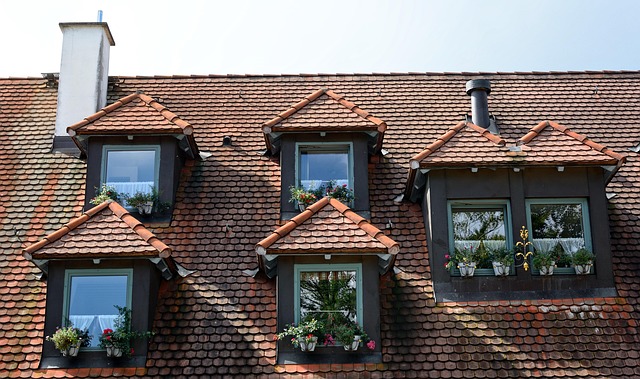Leak-prone flat roofs pose challenges due to installation issues, aging materials, and membrane deterioration. Safety precautions, proper tools, and high-quality waterproof membranes are key for repairs. Effective waterproofing techniques, drainage systems, and regular maintenance extend the lifespan of a flat roof, preventing leaks and saving on costs.
“Flat roofs, despite their low-profiled nature, often pose unique challenges due to their leak-prone tendencies. This comprehensive guide tackles the common causes of leaks in flat roofs, from poor drainage to aging materials. We equip homeowners and professionals with essential preparations for repairs, emphasizing safety measures and necessary tools.
Discover effective waterproofing techniques designed for longevity and learn valuable maintenance tips to prevent future leaks, ensuring a robust and waterproof flat roof.”
- Understanding Leak-Prone Flat Roofs: Common Causes and Challenges
- Preparations for Repairs: Safety Measures and Essential Tools
- Waterproofing Techniques for Long-Lasting Protection
- Maintenance Tips to Prevent Future Leaks and Prolong Roof Lifespan
Understanding Leak-Prone Flat Roofs: Common Causes and Challenges
Leak-prone flat roofs pose a unique challenge for homeowners and contractors alike. Understanding the common causes behind these leaks is the first step in addressing the issue effectively. One of the primary concerns with flat roofs is their inherent vulnerability to water penetration, often due to poor installation or aging materials. Over time, synthetic membranes, like those used in waterproof flat roofs, can deteriorate, developing tears or cracks that allow rainwater to seep through.
Moreover, improper flashing around vents and pipes, lack of proper sealing, or misaligned components can create pathways for water to enter the roof system. These challenges compound when combined with factors such as aging, extreme weather conditions, or poor maintenance. Recognizing these issues is crucial in implementing tailored solutions, ensuring the longevity and reliability of a waterproof flat roof.
Preparations for Repairs: Safety Measures and Essential Tools
Before beginning any repair work on a leak-prone flat roof, it’s crucial to prioritize safety and arm yourself with the right tools. Safety measures should always be at the forefront, especially when dealing with heights. Wear appropriate gear, including a harness, a hard hat, and non-slip boots to ensure your well-being during the process. Ensure proper ventilation in the work area and check the weather conditions; avoid working on wet or windy days as it can compromise both safety and the effectiveness of repairs.
Essential tools for repairing a waterproof flat roof include a high-quality trowel, a bucket, a roller, tar or membrane sheets, a heat gun (for softening old sealant), a utility knife, and a roller brush. Having these tools readily available will streamline the repair process, enabling you to efficiently address leaks and restore the integrity of your flat roof.
Waterproofing Techniques for Long-Lasting Protection
When it comes to repairing a leak-prone flat roof, implementing effective waterproofing techniques is paramount for long-lasting protection. One of the most common and reliable methods involves applying a high-quality waterproof membrane. These membranes are designed to create a robust barrier against moisture intrusion, protecting the roof structure from harmful water damage. They can be installed in various ways, such as using adhesive or mechanical fastening, ensuring a secure fit that withstands harsh weather conditions.
Additionally, incorporating a proper drainage system is essential for any waterproof flat roof. This includes installing slopes or pitches to direct rainwater away from the building’s perimeter, reducing water pressure on the roof surface. By combining robust waterproofing membranes and efficient drainage systems, homeowners can significantly extend the lifespan of their flat roofs, eliminating recurring leak issues and saving on costly repairs.
Maintenance Tips to Prevent Future Leaks and Prolong Roof Lifespan
Regular maintenance is key to preventing leaks and extending the lifespan of your flat roof. One effective strategy is to inspect your roof regularly, looking for any signs of damage or wear and tear. This includes checking for missing or damaged shingles, as well as flashing that may have loosened around pipes or vents. Addressing these issues early can stop small problems from becoming bigger, more costly repairs.
Additionally, applying a high-quality waterproof coating to your flat roof can provide an extra layer of protection against leaks. These coatings seal the surface, preventing water penetration and reducing the risk of damage from moisture build-up. Regular cleaning and sealing of gutters and downspouts are also essential, as clogged or damaged drainage systems can lead to water pooling around your roof, increasing the likelihood of leaks.
Repairing a leak-prone flat roof is a necessary investment in your home’s protection. By understanding the common causes of leaks, implementing safety precautions, and utilizing effective waterproofing techniques, you can significantly extend the lifespan of your roof. Regular maintenance is key; staying proactive with inspections and timely repairs will save you from costly future replacements. Remember, a well-maintained waterproof flat roof ensures your home remains dry and secure for years to come.
